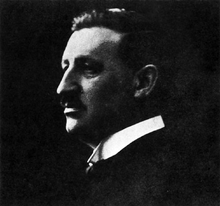Marcel Grossmann
| Marcel Grossmann | |
|---|---|
 | |
| Born |
April 9, 1878 Budapest |
| Died |
September 7, 1936 (aged 58) Zurich |
| Fields | Mathematics |
| Alma mater | University of Zurich |
| Doctoral advisor | Wilhelm Fiedler |
| Notable students | Karl Merz |
Marcel Grossmann (Hungarian: Grossmann Marcell, April 9, 1878 – September 7, 1936) was a mathematician and a friend and classmate of Albert Einstein. Grossmann was a member of an old Swiss family from Zurich. His father managed a textile factory. He became a Professor of Mathematics at the Federal Polytechnic Institute in Zurich, today the ETH Zurich, specializing in descriptive geometry.
Career
In 1900 Grossmann graduated from Zurich Polytechnikum and became an assistant to the geometer Wilhelm Fiedler. He continued to do research on non-Euclidean geometry and taught in high schools for the next seven years. In 1902, he earned his doctorate from the University of Zurich with the thesis On the Metrical Properties of Collinear Structures. In 1907, he was appointed full professor of descriptive geometry at the Eidgenössische Technische Hochschule.
As a professor of geometry, Grossmann organized summer courses for high school teachers. In 1910, he became one of the founders of the Swiss Mathematical Society.
Collaborations with Albert Einstein
Albert Einstein's friendship with Grossmann began with their school days in Zürich. Grossman's careful and complete lecture notes at the ETH were a salvation for Einstein, who missed many lectures.[1] Grossmann's father-in-law helped Einstein get his job at the Swiss Patent Office in Berne, and it was Grossmann who helped to conduct the negotiations to bring Einstein back as a professor of physics at the ETH in Zürich. Grossmann was an expert in differential geometry and tensor calculus; just the mathematical tools Einstein discovered were needed for his work on gravity. Thus, it was natural that Einstein would enter into a scientific collaboration with Grossmann.[2]
It was Grossmann who emphasized the importance of a non-Euclidean geometry called Riemannian geometry (also elliptic geometry) to Einstein, which was a necessary step in the development of Einstein's general theory of relativity. Abraham Pais's book[3] on Einstein suggests that Grossmann mentored Einstein in tensor theory as well. Grossmann introduced Einstein to the absolute differential calculus, started by Christoffel[4] and fully developed by Ricci-Curbastro and Levi-Civita.[5] Grossmann facilitated Einstein's unique synthesis of mathematical and theoretical physics in what is still today considered the most elegant and powerful theory of gravity: the general theory of relativity. The collaboration of Einstein and Grossmann led to a ground-breaking paper: "Outline of a Generalized Theory of Relativity and of a Theory of Gravitation", which was published in 1913 and was one of the two fundamental papers which established Einstein's theory of gravity.[6]
End of Life
Grossmann died of multiple sclerosis in 1936. The community of relativists celebrates Grossmann's contributions to physics by organizing Marcel Grossmann meetings every three years.
Notes
- ↑ An Einstein Encyclopedia, Alice Calaprice, Daniel Kennefick, Robert Schulmann, p.70, Princeton University Press, 2015
- ↑ J. Earman and C. Glymour, Lost in the Tensors: Einstein's Struggles with Covariance Principles, 1912-1916, footnote page 255; Carnegie Mellon University Research Showcase (accessed February 12, 2016)
- ↑ Pais, Abraham (1982). Subtle is the lord: the science and life of Albert Einstein.
- ↑ Christoffel, E.B. (1869), "Ueber die Transformation der homogenen Differentialausdrücke zweiten Grades", Jour. für die reine und angewandte Mathematik, B. 70: 46–70
- ↑ Ricci, Gregorio; Levi-Civita, Tullio (March 1900), "Méthodes de calcul différentiel absolu et leurs applications" (PDF), Mathematische Annalen, Springer, 54 (1–2): 125–201, doi:10.1007/BF01454201
- ↑ Einstein, A.; Grossmann, M. (1913). "Entwurf einer verallgemeinerten Relativitätstheorie und einer Theorie der Gravitation": 225–261.
References
- Pais, Abraham (1982). Subtle is the lord: the science and life of Albert Einstein. Oxford: Oxford University Press. ISBN 0-19-853907-X.
- Einstein, A.; Grossmann, M. (1913). "Entwurf einer verallgemeinerten Relativitätstheorie und einer Theorie der Gravitation" [Outline of a Generalized Theory of Relativity and of a Theory of Gravitation]. Zeitschrift für Mathematik und Physik. 62: 225–261. English translate
- Einstein, A.; Grossmann, M. (1914). "Kovarianzeigenschaften der Feldgleichungen der auf die verallgemeinerte Relativitätstheorie gegründeten Gravitationstheorie" [Covariance Properties of the Field Equations of the Theory of Gravitation Based on the Generalized Theory of Relativity]. Zeitschrift für Mathematik und Physik. 63: 215–225. Bibcode:1914ZMP....63..215E.
- Graf-Grossmann, Claudia, with T. Sauer, Marcel Grossmann: Aus Liebe zur Mathematik, Römerhof-Verlag, Zürich, 2015, ISBN 978-3-905894-32-5
- T. Sauer, ''Marcel Grossmann's contribution to the general theory of relativity'', in: ''Proceedings of the 13th Marcel Grossmann meeting on Recent Developments in Theoretical and Experimental General Relativity, Astrophysics and Relativistic Field Theories'', July 2012. Edited by Robert T. Jantzen, Kjell Rosquist, Remo Ruffini. World Scientific, 2015, pp. 456–503.(http://arxiv.org/abs/1312.4068)
External links
- Marcel Grossmann meetings
- O'Connor, John J.; Robertson, Edmund F., "Marcel Grossmann", MacTutor History of Mathematics archive, University of St Andrews.
- Marcel Grossmann at the Mathematics Genealogy Project